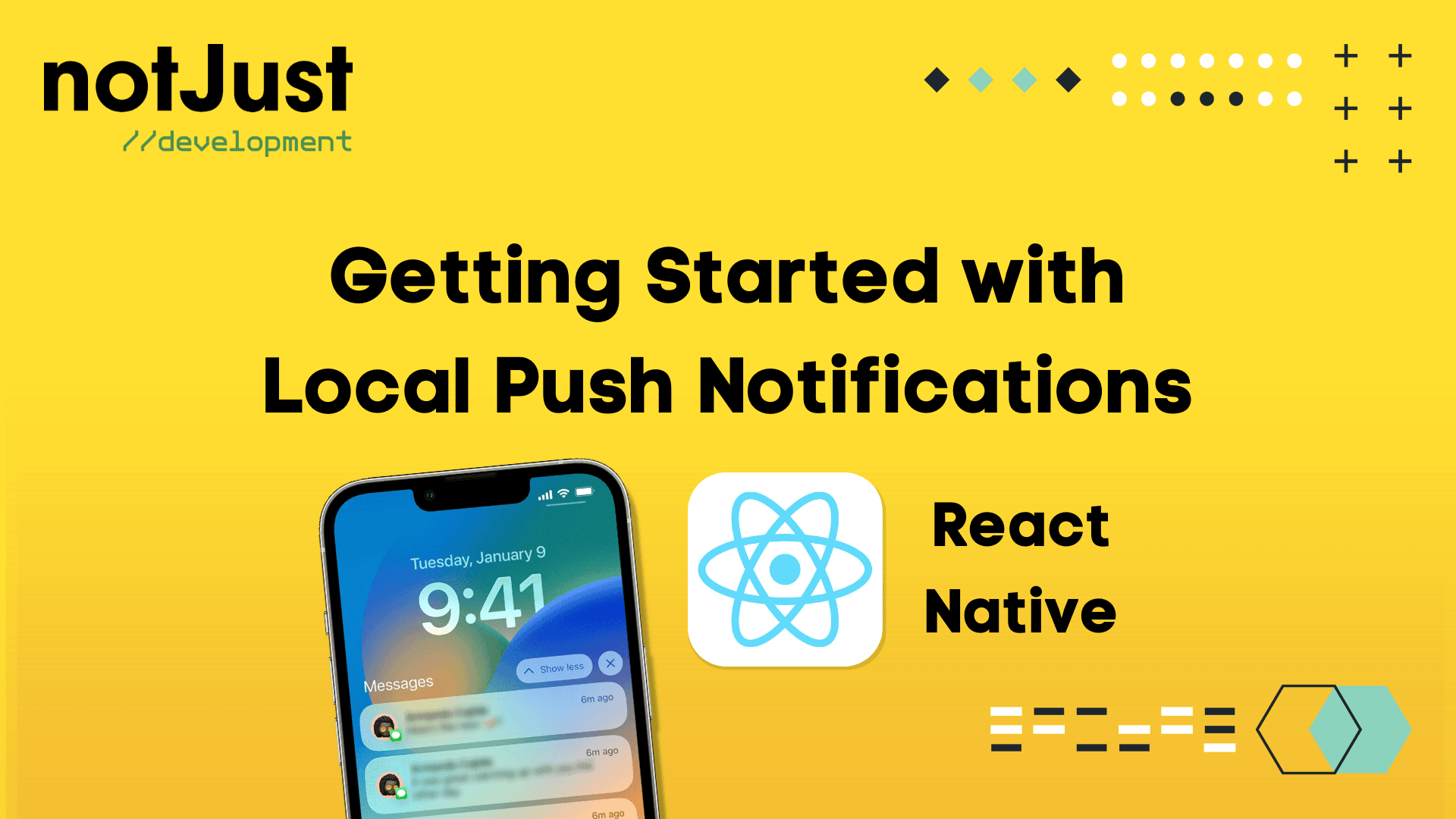Introduction
As an app developer one of the most important things to consider is how to keep your users engaged. Push notifications are a great way to do that. There are two types of push notifications, local and remote. In this tutorial, we will be learning step by step how to set up and use local push notifications in React Native.
What are Local Push Notifications?
Local push notifications are notifications that are sent from your app to the user's device. They are not sent from a server. You do not need to worry about setting up a backend server to send notifications to your users. There are many examples of local push notifications. For example, an alarm app will send a notification to the user when the alarm is set to go off. Another example is a reminder app. A reminder app will send a notification to the user when the reminder is set to go off.
Setting up our project
As always we will be showing a real-life example of how to use local push notifications in React Native. We will be building a simple reminder app that will send a notification to the user when the reminder is set by the users. You can grab the starter code from the Github repo here.
-
Clone the repo.
BASHgit clone https://github.com/notJust-dev/rn-local-push-notifications -
Checkout the starter-code branch.
BASHgit checkout starter-code -
Run yarn to install the dependencies
BASHyarn -
Go to ios folder and run pod install
BASHcd ios && pod install -
Run yarn ios to run the app on iOS
BASHyarn ios
Understanding the sample app
We will create a simple reminder app to learn local push notifications. Our app will have two screens.
In the home screen, the user has two inputs. One is a TextInput to enter the reminder and the other is a DatePicker to set the date and time for the reminder. When the user clicks on the Save button, we will save the reminder in our local storage and show the saved reminders in the home screen. For the brevity of this tutorial we will be just saving a single reminder.
Inside the second screen, we will be showing the reminder that the user has set. We will also be showing a button to delete the reminder. When the user clicks on the delete button, we will be deleting the reminder from the local storage and go back to the home screen. Once the users go back to Home they should see that the reminder is no longer there.
What do we want to achieve?
Great! Our app is up and running. Here comes the juicy part that we all want to learn today. We want achieve the following tasks now in order to learn local push notifications in React Native:
- When the user saves a reminder, we want to send a notification to the user when the reminder is set to go off.
- When the user clicks on the notification, we want to open the app and show the detail screen of the reminder.
- When the user deletes the reminder, we want to cancel the notification that was set for that reminder.
Integrate the Notifee library
With the above tasks in mind, let's first set up the local push notification. We will be using the Notifee library. Notifee is a very well maintained library and it has been recently open sourced. It is a great library to use for local push notifications in React Native. Let's install the library first.
yarn add @notifee/react-native
Now we need to link the library to our project. We can do that by running the following command.
cd ios && pod install
Awesome, now we have the amazing notifee library installed in our project. Let's start using it!
Set up the Notification Class
In order to work with notification we want to create a class that will handle all the notification related tasks. We will be creating a Notification class in the src folder. I will first give you the code for the Notification class and then we will go through together -
import notifee, {AuthorizationStatus,EventType,Notification,} from '@notifee/react-native';class Notifications {constructor() {// Bootstrap method is called when the app is launched from a notificationthis.bootstrap();// Listen for events// This is called when the app is in the foregroundnotifee.onForegroundEvent(({ type, detail }) => {switch (type) {case EventType.DISMISSED:console.log('User dismissed notification', detail.notification);break;case EventType.PRESS:console.log('User pressed notification', detail.notification);break;}});// This is called when the app is in the backgroundnotifee.onBackgroundEvent(async ({ type, detail }) => {const { notification } = detail;console.log('Notification received: background', type, detail);if (notification) {this.handleNotificationOpen(notification);}});}// This method deals with what what happens when the user clicks on the notificationpublic handleNotificationOpen(notification: Notification) {const { data } = notification;console.log('Notification Opened', data);}// This method is called when the app is launched from a notificationpublic async bootstrap() {const initialNotification = await notifee.getInitialNotification();if (initialNotification) {this.handleNotificationOpen(initialNotification.notification);}}// This method is called to check if the user has granted permission to send notificationspublic async checkPermissions() {const settings = await notifee.requestPermission();if (settings.authorizationStatus >= AuthorizationStatus.AUTHORIZED) {console.log('Permission settings:', settings);return true;} else {console.log('User declined permissions');return false;}}}// Exporting an instance of the classexport default new Notifications();
Let's go through the code together.
- First, we import the necessary modules from the @notifee/react-native library.
- We create a class called Notifications and we export an instance of the class at end of this file. We will be using the instance of the class to call the methods. So whenever we import this class, we will be getting the instance of the class. Our whole project will only have one instance of the class. This is also known as a singleton class.
- We create a constructor for the class. In the constructor, we call the bootstrap method. We will be using this method to get the initial notification when the app is opened from a notification. We also have 2 event listeners. One for the foreground event and the other for the background event. If the app is on the foreground and the user clicks on the notification, we will be using the foreground event listener to get the notification. If the app is in the background and the user clicks on the notification, we will be using the background event listener to get the notification.
- The handleNotificationOpen method is responsible for handling the notification when the user clicks on it. We will send the notification details to this method and add our own logic to handle the notification.
- Finally the checkPermissions method is responsible for checking if the user has granted the permission to send notifications to the device.
Task 1: Schedule a notification when the user saves a reminder
Awesome, so far we have the barebone code for our notification class. Now we will connect this class to our reminder app. Let's create a method to schedule a notification when user saves a reminder in our home screen. I will add a new method called scheduleNotification in the Notifcation class.
import notifee, {AuthorizationStatus,EventType,Notification,TimestampTrigger,TriggerType,} from '@notifee/react-native';public async scheduleNotification({reminder,date,}: {reminder: string;date: Date;}) {// Check if the user has granted the permission to send notificationsconst hasPermissions = await this.checkPermissions();// If the user has granted the permission, schedule the notificationif (hasPermissions) {// Create a timestamp trigger for the notificationconst trigger: TimestampTrigger = {type: TriggerType.TIMESTAMP, // This is the type of trigger, we have other types of triggers as welltimestamp: +date, // +date converts the date to timestamp};// Create the notification detailsconst notificationDetails = {id: '1',title: `🔔 You asked for this reminder - ${reminder}`,body: 'Tap on it to check',android: {channelId: 'reminder',pressAction: {id: 'default',},},data: {id: '1',action: 'reminder',details: {name: reminder,date: date.toString(),},},},// Schedule the notificationawait notifee.createTriggerNotification(notificationDetails,trigger,);}}
Okay, let's go through the code together now.
- We first check if the user has granted the permission to send notifications to the device. If the user has granted the permission, we will schedule the notification. If the user has not granted the permission, we will not schedule the notification.
- Notifee library has a method called createTriggerNotification which can be used to schedule a notification. This method needs 2 parameters. The first parameter is the notification details and the second parameter is the trigger.
- The first parameter is the notification details. We will be passing the notification title, body, and data. The data is the data that we want to send to the notification when the user clicks on it. Later this data can be used to handle the notification.
- The second parameter is the trigger. We will be using the TimestampTrigger type. This trigger will be used to schedule the notification. In order to set a time, we will use the timestamp.
Let's now call this method in the saveReminder method. Because we are saving the reminder in this method and at the same time we want to schedule the notification. Go to Home and modify the saveReminder method.
const saveReminder = async () => {const reminderObject = {name: reminder,date: date.toString(),};............// Schedule the notification// Here we are passing the reminder string and date to the scheduleNotification methodNotification.scheduleNotification({reminder, date: date});};
Amazing! We will now test if the notification is working or not. Let's run the app and save a reminder. If everything is working fine, we should get a notification on the device.
Task 2: Handle the notification when the user clicks on it
Our next task is to show the reminder details when the user clicks on the notification. We will be using the data property of the notification to get the reminder details.
There are few scenarios when the user clicks on the notification. They are the following:
- Your app is in the foreground and the user clicks on the notification.
- Your app is in the background and the user clicks on the notification.
- Your app is not running and the user clicks on the notification.
We will be handling all these scenarios in our app. Let's start with the first scenario. When the app is in the foreground and the user clicks on the notification, we will be using the onForegroundEvent event listener. Go to the Notifications class and modify the constructor method.
import notifee, {AuthorizationStatus,EventType,Notification,TimestampTrigger,TriggerType,} from '@notifee/react-native';constructor() {....// This event listener will be called when the app is in the foreground and the user clicks on the notification// detail contains the notification detailsnotifee.onForegroundEvent(({type, detail}) => {switch (type) {case EventType.DISMISSED:// we don't care about this eventbreak;case EventType.PRESS:// Our data is in the detail.notification.data property// we pass the notification to the handleNotificationOpen methodthis.handleNotificationOpen(detail.notification);break;}});......}
Secondly, when the app is in the background and the user clicks on the notification, we will be using the onBackgroundEvent event listener. Go to the Notifications class and modify the constructor method.
constructor() {....// This event listener will be called when the app is in the background and the user clicks on the notification// detail contains the notification detailsnotifee.onBackgroundEvent(async ({type, detail}) => {const {notification} = detail;if (notification) {this.handleNotificationOpen(notification);}});......}
Finally, when the app is not running and the user clicks on the notification, we will be using the getInitialNotification method. getInitialNotification is triggered that gets called when the app is not running and the user clicks on the notification.
constructor() {this.bootstrap();.........}......public async bootstrap() {const initialNotification = await notifee.getInitialNotification();if (initialNotification) {this.handleNotificationOpen(initialNotification.notification);}}
Great, we are handling all the scenarios of user clicking on the notification. Now what do we want to do when the user clicks on the notification? We want to do the following:
- Get the reminder details from the notification data.
- Navigate to the Detail screen and pass the reminder details to it.
- Show the reminder details on the Detail screen.
From all the above cases, we should have already noticed that we are calling the handleNotificationOpen method and passing the notification to it. We already have all the details. We just need to navigate to the detail screen and pass the detail as params. However, our Notification class can not handle navigation. It does not know what is the navigation object. Thanks to the react-navigation, we can also use Navigation object outside the screens or components. We will need to add a few lines of code to make this work.
First create a new file called RootNavigation.js in the src folder. Add the following code to the file.
import { createNavigationContainerRef } from '@react-navigation/native';export const navigationRef = createNavigationContainerRef();export function navigate(name, params) {if (navigationRef.isReady()) {navigationRef.navigate(name, params);}}
Then import this navigationRef in the App component and pass it to the NavigationContainer component.
......import {navigationRef} from './RootNavigation';const Stack = createNativeStackNavigator();function App(): JSX.Element {return (<NavigationContainer ref={navigationRef}>......</NavigationContainer>);}
With that out of the way, we can now import RootNavigation and use the navigate method to navigate to the detail screen. Go to the Notifications class and modify the handleNotificationOpen method.
import * as RootNavigation from './RootNavigation';public handleNotificationOpen(notification: Notification) {const {data} = notification;RootNavigation.navigate('Detail', {savedReminder: data?.details});}
Wohoo! We are done. Let's test it out. Run the app and save a reminder. Then click on the notification. You should see the reminder details on the Detail screen.
Task 3: Cancel the notification when the user deletes the reminder
Our last task is to cancel the notification when the user deletes the reminder. Why do we want to cancel the notification if the user deletes the reminder? If we don't cancel the notification, the user will still get the notification even if the reminder is deleted. We will be using the cancelNotification method of the notifee library to cancel the notification. First, we will create a new method called cancelNotification in the Notifications class.
public cancelNotification() {// for now we are just cancelling the notification with id 1 to keep the example easy.notifee.cancelNotification("1");}
Then we will call this method from the Detail screen when the user deletes the reminder. Go to the Detail screen and modify the onPress method of the Delete Reminder button.
<Buttontitle="Delete Reminder"onPress={() => {AsyncStorage.removeItem('reminder');Notification.cancelNotification();navigation.navigate('Home', { refresh: true });}}/>
Now when the user deletes the reminder, he or she will not see any push notification!
So far we have been testing on the iOS simulator. But it should work the same for the Android device as well.
Conclusion
In this tutorial, we have covered the basics of local push notifications in React Native. We have created a simple app that allows the user to save a reminder and get a push notification when the reminder is due. We have also covered how to handle the notification when the user clicks on it. At the same time we also covered how to cancel the notification when the user deletes the reminder. I hope you enjoyed reading it and this tutorial will help you in your future projects.
Get the code
You can get the code for this tutorial from GitHub repository.



